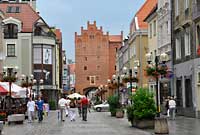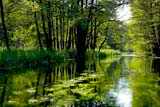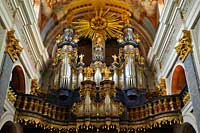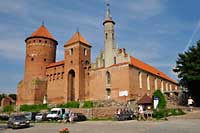THE MASURIAN LAKE DISTRICT

The route of this extremely attractive tour leads through the most outstanding areas of the Masurian Lake District, known as 'The Land of a Thousand Lakes', and reaches northward up to the Polish - Russian border. En route there are landscape parks, numerous nature reserves and the famous Biosphere Reserve - Luknajno Lake. The route is about 800 kilometres long.
ITINERARY

DAY ONE
Arrive in Warsaw and transfer by coach to Nidzica (150 km) pausing en route to visit the vast water meadows in the Orzyc river valley. Amongst the birds which nest here are: Black Stork Ciconia nigra, Honey Buzzard Pernis apivorus, Marsh Harrier Circus aeruginosus, Montagu's Harrier C. pygargus, Lesser Spotted Eagle Aquila pomarina, Black Grouse Tetrao tetrix, Corncrake Crex crex, Crane Grus grus and Black-tailed Godwit Limosa limosa.
Overnight stay in Nidzica.
DAY TWO
To the north-east of Nidzica is an extensive forest complex with numerous lakes, bogs and fens. It will be the focus of our full day trip. About 160 species of birds nest in this area including: Grebes - Great Crested Podiceps cristatus, Red-necked P. grisegena and Black-necked P. nigricollis, Bittern Botaurus stellaris, Little Bittern Ixobrychus minutus, Black Stork Ciconia nigra, Goldeneye Bucephala clangula, Goosander Mergus merganser, Honey Buzzard Pernis apivorus, Osprey Pandion haliaetus, White-tailed Eagle Haliaetus albicilla, Red Kite Milvus milvus, Marsh Harrier Circus aeruginosus, Lesser Spotted Eagle Aquila pomarina, Hobby Falco subbuteo, Black Grouse Tetrao tetrix, Corncrake Crex crex, Crane Grus grus, Black Tern Chlidonias niger, Eagle Owl Bubo bubo, Kingfisher Alcedo atthis, Roller Coracias garrulus, Green Woodpecker Picus viridis, Great Grey Shrike Lanius excubitor, and Nutcracker Nucifraga caryocatactes.
In the afternoon we transfer for an overnight stay in the vicinity of Barczewo, close to Olsztyn.
DAY THREE
In the morning we make a birdwatching visit to Bartolt Wielki Lake, close to Barczewo. It is soon to be designated as a nature reserve, and birds which nest here include: Black Stork Ciconia nigra, Honey Buzzard Pernis apivorus, Black Kite Milvus migrans, Red Kite M. milvus, White-tailed Eagle Haliaetus albicilla, Marsh Harrier Circus aeruginosus, Lesser Spotted Eagle Aquila pomarina, Corncrake Crex crex and Crane Grus grus.
Later we travel through Masuria, north-east almost to the Polish - Russian border (150 km) pausing en route at the Fuledzki Rog Peninsula, a perfect view point at the Dobskie Lake nature reserve (1830 ha). The reserve was primarily established to protect birds, which stop there on passage.
Overnight stay in the resort of Wegorzewo.
DAY FOUR
Today we visit the ornithological reserve at Oswin Lake (Ramsar Site, 1800 ha), which protects the lake as well as surrounding water meadows and forests. The reserve supports many species of birds, for example: Great Crested Grebe Podiceps cristatus, Black-necked Grebe P. nigricolis, Bittern Botaurus stellaris, Greylag Goose Anser anser, Gadwall Anas strepera, Teal Anas crecca, Shoveler Anas clypeata, Marsh Harrier Circus aeruginosus, Lesser Spotted Eagle Aquila pomarina, Water Rail Rallus aquaticus, Little Crake Porzana parva, Corncrake Crex crex, Crane Grus grus, Bluethroat Luscinia svecica and Bearded Tit Panurus biarmicus. Return for an overnight stay in Wegorzewo.
DAY FIVE
From Wegorzewo we travel along the edge of Borecka Forest to Sniardwy Lake, the largest in Masuria and in Poland. On the way we can stop at the Nietlickie Swamps where thousands of Cranes gather in the autumn. But our main aim today is the Luknajno Lake, adjoining Sniardwy Lake. It is a Biosphere Reserve as well as Ramsar Site (710ha)
This shallow lake, partly covered by vegetation, together with the surrounding water meadows is where over 120 species of birds nest, and flocks of birds stop during passage. Nesting birds include: Little Grebe Tachybaptus ruficollis, Great Crested Grebe Podiceps cristatus, Red-necked Grebe P. grisegena, Black-necked Grebe P. nigricollis, Bittern Botaurus stellaris, Little Bittern Ixobrychus minutus, Mute Swan Cygnus olor, Pintail Anas acuta, Goldeneye Bucephala clangula, Marsh Harrier Circus aeruginosus, Hobby Falco subbuteo, Spotted Crake Porzana porzana, Little Crake P. parva, Black Tern Chlidonias nigra and Bearded Tit Panurus biarmicus.
Some birds of prey such as Kites, White-tailed Eagle Haliaetus albicilla, Osprey Pandion haliaetus, and Lesser Spotted Eagle Aquila pomarina come here to feed.
After visiting Luknajno Lake we transfer to the picturesque village of Krytyn for an overnight stay.
DAY SIX
In Krytyn village is the office of the Masurian Landscape Park (50000ha). The Park protects a highly diversified area - numerous lakes with surrounding forests, swamps, water meadows and traditionally cultivated fields. Over 200 species of bird have been recorded, about 150 of them breeding, for example: four species of Grebe, Cormorant Phalacrocorax carbo, Bittern Botaurus stellaris, White and Black Stork Ciconia ciconia and C. nigra, Goldeneye Bucephala clangula, Goosander Mergus merganser, Honey Buzzard Pernis apivorus, Black and Red Kite Milvus Migrans and M. milvus, Lesser Spotted Eagle Aquila pomarina, Osprey Pandion haliaetus, White-tailed Eagle Haliaetus albicilla, Marsh, Montagu's and Hen Harrier Circus aeruginosus, C. pygargus and C. cyaneus, Black Grouse Tetrao tetrix, Spotted Crake Porzana porzana, Crane Grus grus, Tengmalm's Owl Aegolius funereus, Eagle Owl Bubo bubo, Nightjar Caprimulgus europaeus, Golden Oriole Oriolus oriolus, Penduline Tit Remiz pendulinus, Common Rosefinch Carpodacus erythrimus and Common Crossbill Loxia curvirostra.
Our first day in the Park we will spend drifting by canoes along the Krutynia River. This picturesque river flows, in its lower part, through lakes deep in the forest. It will provide us with a perfect opportunity for birdwatching. Return to Krutyn for an overnight stay.
DAY SEVEN
We will continue exploring the Masurian Landscape Park. With luck you are likely to see Golden Eagle Aquila chrysaetos high in the sky. Return to Krutynia for a farewell bonfire and overnight stay.
DAY EIGHT
Transfer to Warsaw (200 km) and depart for home.
OPTIONAL VISITS
During this tour optional visits can also be made to the following important historical monuments:- Warsaw - the biggest town and capital of Poland, totally destroyed during the Second World War. The old city, carefully reconstructed after the War, has been recognised as a World Heritage Site
- Olsztyn - the old centre with its gothic castle and St. James church
- The medieval castles of the Teutonic Knights in Nidzica, Ketrzyn and Reszel
- The baroque church with its famous organ in Swieta Lipka
- Gierloz - the ruins of the great bunkers known as 'Wolfschanze' which were Hitler's headquarters during the War and the site of the 1944 July bomb plot, the attempt on his life













